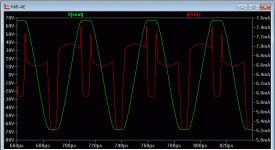Happy Birthday brother Pete!
Sorry for being a bit late, but from the other side of the planet... it takes some time
Sorry for being a bit late, but from the other side of the planet... it takes some time

It would be even more interesting to see how the circuit behave when followed by an output stage and FB loop closed. The compensation schemes and possibilities are also quite intriguing. Before having a chance putting it to simulator I personally have a bit of concern about the output impedance of the VAS being possibly higher than we would like it to be at high frequencies, which may not be a good news for 3EF OPS stability.
That is why I am using those 10-15pf shunts at the VAS collectors.
Seems to run real nice with the slew EF3.
With just Miib's 5pf lead comp.(from VAS) , it was insufficiently damped (ringing).
Tuned the bode response , tested square waves , and PSSR.
I now know where it excels (very high output) .... keeps 10ppm 20K 140V p-p.
The mirrors are "holding it together" at these obscene levels.
OS
Thanks to the common base configuration of the VAS ?THD was slightly better on the "alien" Slew was impressive !!
Please, not. But a data table in the first POST with all the versions and characteristic of each should be welcomed. I'm too lost in all those strange names ;-)OS, please start a new thread for this. This one is sooooooo looooong!
VFA or CFA, Slew rate, Distortions @ 1 & 10K, output power etc...
Last edited:
piracy and thievery posts deleted...please stick to topic.....
For the record, its copyright infringement, not theft

The current-source can be made floating just by removing The GND connection on The VBE currentsource set-transistors, this will prevent any possibility of dirty ground sneaking into the circuit.
When you have a servo the GND connection is good to have in order to have a good reference.
For the input transistors find some good doubles, then performance will be stellar.
The VAS cascode can also be set with a LED reference to rails.
I like the added compensation to GND, It just may be the better option
When you have a servo the GND connection is good to have in order to have a good reference.
For the input transistors find some good doubles, then performance will be stellar.
The VAS cascode can also be set with a LED reference to rails.
I like the added compensation to GND, It just may be the better option
The current-source can be made floating just by removing The GND connection on The VBE currentsource set-transistors, this will prevent any possibility of dirty ground sneaking into the circuit.
When you have a servo the GND connection is good to have in order to have a good reference.
For the input transistors find some good doubles, then performance will be stellar.
The VAS cascode can also be set with a LED reference to rails.
I like the added compensation to GND, It just may be the better option
I did that (below) , as well as make the CSS Re's globally adjustable to set
the current of the TIS. Injected my servo reference there , too.
I'll do both this one and the symetri ... one simple , one hard. AE is just short
of the spooks part count.
(below 2) AE self clamps on overload , as well. All parts conduct less (clamp).
.ASC below ....
OS
Attachments
Are these gerbers from the final version??I've exported the files from Sprint 6.
Last edited:
Are these gerbers the final version??
Yes. I made them from OS's files.
So is it a problem if i post here this last version bitmap images?Yes. I made them from OS's files.
Last edited:
So is it a problem if i post here bitmap images from this last version?
You want files to etch from?
I can produce these from Gerber ,i wonder if it is useful posting these here 🙂You want files to etch from?
Last edited:
I don't think anyone will mind if you post them. I can post them in PDF if that works better too.
I can produce these from Gerber ,i wonder if it is useful posting these here 🙂
Which IPS?
thanks
How did your double sided boards come out? Are you up for testing Kypton-ND files?
- Home
- Amplifiers
- Solid State
- Slewmaster - CFA vs. VFA "Rumble"


